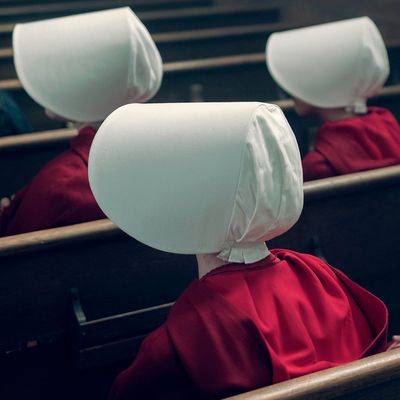
Last week’s episode of The Handmaid’s Tale was brutal: June gives birth by herself in an abandoned mansion, torn between whether to escape or whether to seek medical help as she nearly bleeds to death. It was harrowingly tough to watch, which meant it was basically par for the course for the show. But there’s one moment that feels as though it was beamed in from an entirely different world.
When June finds a classic car abandoned in a garage, turns it on, and tunes the radio, she hears a familiar voice: Oprah Winfrey, broadcasting from “somewhere in the Great White North.” Oprah delivers some vague political news about “additional sanctions on Gilead,” economic aid for the “American Government in Anchorage,” and the U.K.’s “plans to raise the cap on American refugees” before dedicating a song as a reminder that “we are still here — Stars and Stripes forever, baby.” Cue Bruce Springsteen’s “Hungry Heart.”
There’s an obvious unanswered question here: Is Oprah playing a character, or is Oprah playing herself? If it’s the former, then casting Oprah is a weird choice that distracts from the moment. If, instead, we’re supposed to think that this is the Oprah — that she actually exists in this world, then fled the Gilead civil war to become a resistance radio DJ — well, if that’s what’s going on, then I have so many more questions.
If Oprah Winfrey is broadcasting news and tunes to get the word out about what’s left of the American government, then where are all the other celebrities? Where is Beyoncé? Where is Roseanne? Where is Tom Brady? Or Justin Bieber? Or Taylor Swift? Or Kim Kardashian?
Sure, we can make some guesses. We know from season two that Alaska and Hawaii are both free from Gilead’s clutches, and that Canada and the U.K. have taken in American refugees. Lots of celebrities probably fled to the new American capital in Anchorage, or expatriated to elsewhere in the world. Obviously celebrities have money and power, and they surely saw the writing on the wall and were able to escape.
This is admittedly a silly question. The Handmaid’s Tale is a dark parable about what can happen when we succumb to fear and cede individual freedoms to an authoritarian government that promises to make everything better, and it’s specifically about the horrible way this plays out for one woman’s life. It’s about how marginalized classes get their humanity stripped away in order to further empower the patriarchy, the ways women can betray each other to protect themselves, and the horrors of “ends justify the means” thinking. If we’re going to take The Handmaid’s Tale on its own terms, the mysterious unexplained location of Carrie Underwood is hardly the most important thing to focus on.
But still, asking “Where did Jimmy Fallon go?!” is a surprisingly useful way to think about the challenge of expanding Margaret Atwood’s deliberately claustrophobic novel into a fully developed dystopian world. It’s also the kind of unanswered question that’s gotten more noticeable in season two. Even before Oprah showed up, we’ve seen more and more moments where The Handmaid’s Tale has explicitly connected its pre-Gilead world to our current reality. There are more flashbacks to the past, more references to pop culture, and more memories of real places and experiences. Serena Joy goes on a speaking tour and gets screamed off a college campus, in what’s clearly meant as a nod to free speech debates and far-right figures like Milo Yiannopoulos. When June holes up in the Boston Globe’s abandoned offices at the beginning of the season, she watches a ton of Friends. In a flashback, she tells her mother she wanted to marry Jordan Catalano. There are even references to Tinder and Twitter.
If Gilead came out of a world with Friends and Twitter, surely it would’ve also come out of a world where we define our identities through the celebrities we love (or the ones we hate). So, again, where did all the celebrities go? It’s not just that these people are noticeably missing, it’s the corollary suggestion that celebrity was somehow excised from Gilead. Even more curiously, the cults of personality that define our political spectrum apparently played no role in the formation of Gilead. If Serena Joy was a Fox News–like conservative figure before she was stripped of the right to read, wouldn’t Gilead be full of TVs blasting state propaganda, carefully scrubbed of all text so women could still watch? There was no Fox News when Atwood wrote the book, but I have to imagine that if one were to invent a Gilead now, cable news would play a big role. Its absence makes Gilead’s dystopia a very hard one to imagine, especially because our current, real-life political nightmare is spearheaded and defined by a reality-TV-supported idolatry.
Ultimately, the celebrity question is of a piece with the show’s broader strengths and weaknesses: The Handmaid’s Tale is remarkably good at the oppressive, unbearable experience of June’s imprisonment in the Waterfords’ house, but whenever its story reaches out toward a larger image of Gilead — its political framework, its powerful figures, its racism, the way it functions — everything gets very thin. The world of the show has gotten bigger in season two. We’ve seen more of Canada, more households like the Waterfords’, and more of the characters who populate them. But Gilead itself is still a parable.


